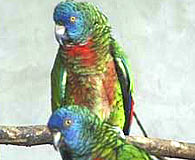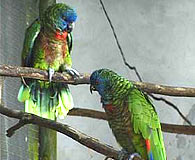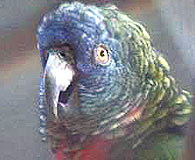Status and Conservation
Status: Endangered
By 1975 as few as 100 parrots survived in the wild. Combined pressures from
deforestation and shooting were taking their toll. The St. Lucia Forestry and
Lands Department initiated and island-wide education programme while protecting
substantial areas of rainforest and banning all hunting until further notice.
The Jacquot became the National Bird in 1979, the year of St. Lucia's
independence, and the Jersey Wildlife Preservation Trust was invited to collect
fledglings from the nest to begin the world's only breeding program at Forestry
Headquarters.
Now, JWPT, WPTI, and St Lucia Forestry officers are studying the parrots in
their aviaries and in the forest to perfect breeding techniques. The number of
St. Lucia parrot in the wild has almost tripled since conservation measures were
first introduced.
Much of the St. Lucia parrot’s original habitat was lost through forest
clearance for agriculture or hunting. By 1975 as few as 100 parrots
remained in the wild. At that point, the Government of St. Lucia and the
Jersey Wildlife Preservation Trust collected seven parrot fledglings from
their nest and established a breeding programme in Jersey. Simultaneously,
a Forest Department education programme was successfully converting St.
Lucians’ attitude towards their unique parrot.
In 1979, the year of the country’s independence, the St. Lucia parrot was
officially named the National Bird. Further, all hunting was banned and a
large area of the rainforest was declared a Parrot sanctuary.
By
November 1998 fourteen (14) healthy chicks had been reared in Jersey from
which the Prime Minister of St. Lucia collected two (2) young parrots
destined for St. Lucia’s own breeding programme.
The best news of all is that the decline of the wild population has been
reversed, and numbers have increased tremendously since conservation
measures were introduced to St Lucia. |



